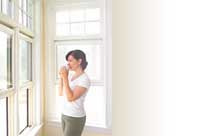Window Replacement: Find, fix and forget - simple steps to weatherize your home this winter
| Tweet |
Luckily, for many homeowners, problem areas where cold air is sneaking in - and warm air may be escaping - can easily be found, fixed and then forgotten. According to the U.S. Department of Energy, the annual energy bill for a typical single family home is about $2,200.
Here are a few simple do-it-yourself steps to keep the warm air - and cost savings - in your home this winter:
* Find. Perform a home energy audit to determine where you might have some issues. While you can pay a professional, this can also be done quickly with a simple list and a few household items.
To start, make a list of potential problem areas, including windows and doors, as well as places where pipes, electrical outlets, vents and mail slots are located.
To complete the audit, make sure all doors, windows and fireplace chutes are closed, shut off all combustion appliances, and turn on exhaust fans (in the kitchen and bathrooms, if you have them). Then, take a lit incense stick or candle and hold it in front of the areas you listed as possible problem sources - leaks and drafts will cause the smoke or flame to flow in the direction of the air leak. Be sure to keep track of any areas in need of sealing.
You can also shine a flashlight around doors and windows to look for gaps and cracks - if you see light shining through, you've likely found an area in need of fixing.
* Fix. Once you've determined the areas that need attention, look for DIY weatherization products that can help. Many cost-effective, easy-to-install solutions are on the market today, with many formulated for specific problem areas.
For leaks around pipes, electrical outlets, vents or mail slots, consider caulk or other specialized products, like foam seals, to block the drafts.
Drafts around windows can be fixed with a window insulation kit, typically a clear plastic film that can be placed on the inside or outside of the window to create a draft-proof seal that can easily be removed when the cold air clears out.
Additionally, many window and door seals can be applied quickly and easily, but don't forget about the bottom, where cold air might be creeping in.
For leaks under doors and windows, look for a solution that will "hug" the bottom to create an airtight barrier. The Double Draft Seal from Duck brand offers two layers of protection from drafts, sealing underneath doors and windows from both sides, for maximum energy efficiency and thermal protection.
* Forget. Take the time to fix the problem areas now and you'll forget you had any air leaks and drafts by the time the weather turns frigid and frightful.
For DIYers, it's as simple as taking the time to find the cold air sources, choosing the right products to block the drafts and installing them properly.
The fall offers many perfect opportunities to get DIY weatherization done. And, many of these projects can be completed in a weekend and then forgotten throughout the cold winter months - all without breaking the bank. For more information and tips to winterize your.


|
Respond Home Improvement Directory lists the top Replacement Window Contractors in your area, organized by specialty and office location. |
| Top Cities | |
|
Atlanta
Chicago New York |
Los Angeles
Philadelphia Washington DC |
| Canadian Cities | |
|
Calgary
Edmonton Ottawa |
Toronto
Vancouver Winnipeg |





